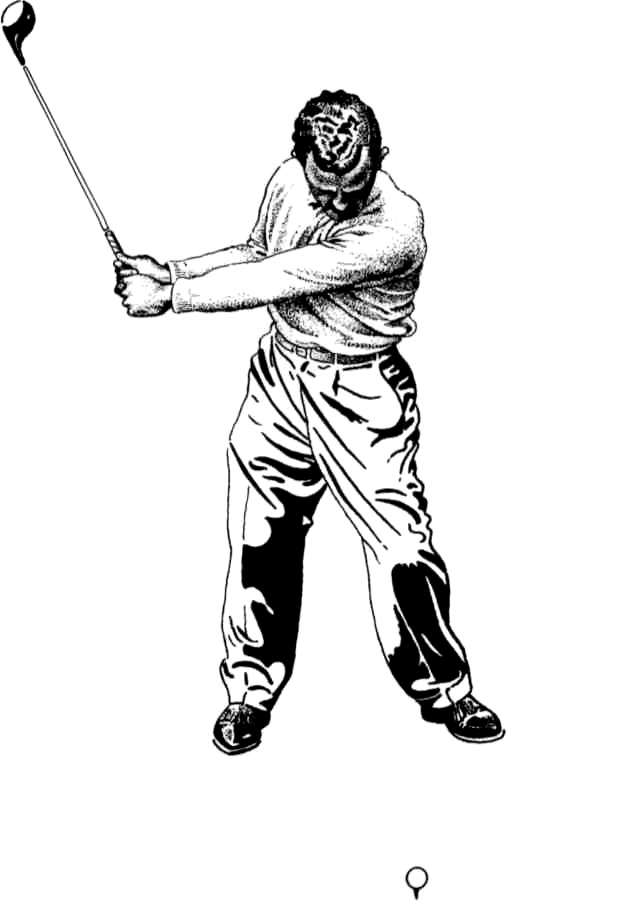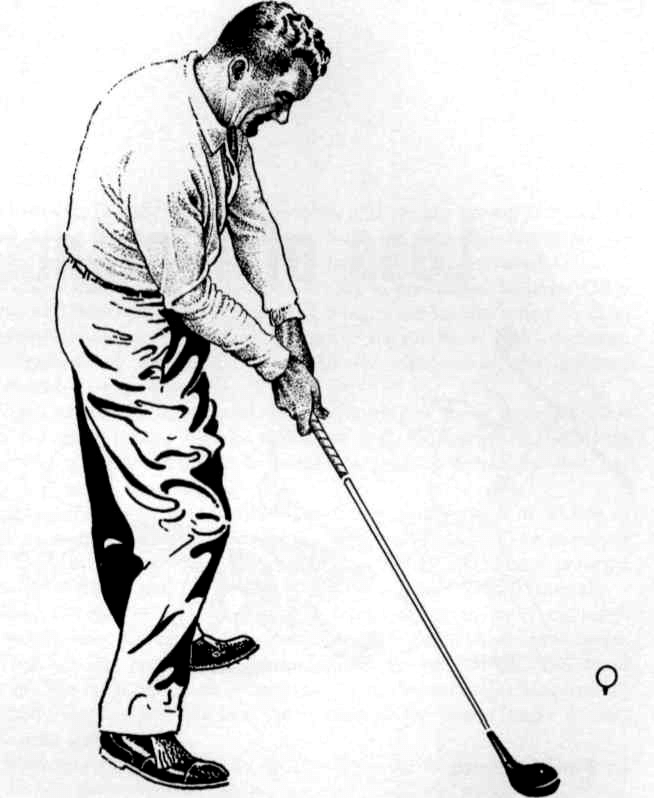The pulled shot is one that travels in more or less a straight line, but to the left of target. Like its counterpart, the push, which flies on a straight line, but to the right of target, the pulled shot usually “feels good” since it is struck with the meat of the clubface in a square, rather than glancing blow.
The pull, though squarely met, goes left because the clubhead is moving from outside to inside, across the target line, during impact. This is directly opposed to the push, which finds the clubhead moving from inside to outside the imaginary line from ball to target.
It is impossible to pull a shot without the clubhead moving in the outside-in pattern. Thus, to correct a pull the golfer must ascertain what is causing the outside-in swing.
He or she must then replace such a movement with a pattern that finds the clubhead moving from inside the target line, to along this line during impact, and then returning to the inside after the ball is away — in short, an inside-in clubhead pattern.
Causes of the pulled shot are usually found in failure to properly coil the body on the backswing: failure to shift weight to the right on the backswing and the left on the downswing, and failure to delay uncocking of the wrists on the downswing.
All of these faults will produce an outside-in clubhead movement and, in turn, pulled shots. It is not surprising that persons who normally are plagued with sliced shots to the right occasionally discover their shots pulling to the left.
The reason for this is that the outside-in clubhead path is inherent to both the slice and the pull. The only difference between the two is the position of the clubface during impact. In the case of the slice it faces directly at, or to the right of, the target. In the pull it is slightly closed to the left of target.
In this article, we will further discuss the causes of a pull shot and provide ways in which you can cure it. Let’s take a look.
Here is how to stop pulling your golf ball to the left:
- Coil the body around a fixed “axis” on the backswing
- Allow weight to shift to inside the right foot on the backswing
- Allow the wrists to uncock naturally into the ball
- Keep right elbow in tight
Table of Contents
4 Tips To Stop Pulling Golf Golf Ball To The Left
1. Coil The Body Around A Fixed “Axis” On The Backswing
One of the reasons why you pull the golf ball to the left is that you are swaying, or moving the body laterally to the right, on the backswing.
As a golfer sways to the right on the backswing, it is only natural that the club head may move outside the target line.
Thus, it is likely that the club will return to the ball from the outside. A pull, or a slice, will be the result.
Pull error: Swaying, or moving the body laterally to the right, on the backswing

Imagine that you have a pole running from inside your right foot, up your right leg and through the top of your head.
Then make sure that your head, shoulders and hips swivel around this pole on the backswing, without moving laterally to the right.
The result will be a coiling of shoulder, back and leg muscles which, in turn, will cause the club head to move inside the target line.
As a golfer sways to the right on the backswing, it is only natural that the club head may move outside the target line. Thus, it is likely that the club will return to the ball from the outside. A pull, or a slice, will be the result.
Correct

2. Allow Weight To Shift To Inside The Right Foot On The Backswing
Failure to shift some weight to the right foot on the backswing often causes a player to shift it to the right on the downswing instead — to fall back on his right foot. This, in turn, forces the club head outside the target line.
Pull error: Weight remains on the left side during the backswing

The player should feel a rhythmical motion that moves his weight momentarily to the right foot. Then, this weight should return to the left foot immediately at the start of the downswing with a turn of the left hip and a lowering of the left heel.
This proper weight shifting will enable the player to take the club back on the inside and retain it there throughout the downswing.
Correct

3. Allow The Wrists To Uncock Naturally Into The Ball
Then we have the golfer who has proper coiling and weight transfer on the backswing, but who jerks the club down to the ball in his anxiety to put the shot into flight.
This premature uncocking of wrists on the downswing destroys the flowing motion of weight to the left side. Instead the weight remains on the right foot and the club head enters the hitting area from outside the target line
Pull error error: Hitting from the top

The player should feel that everything is moving to the left on downswing in a smooth, unhurried fashion, pulling the still-cocked wrists down and through the ball.
There should be no sensation of forcing the club. The wrists should uncock naturally as result of the uncoiling of the shoulders.
Correct

4. Keep Right Elbow In Tight
When the wrists are uncocked too early on the downswing, the right elbow tends to move away from the body. This, along with a poor weight shift, forces the club head outside target line.
Pull error: “Flying” right elbow

If the wrists are allowed to “break” naturally, the club head will move from inside the target line and meet the ball squarely at impact.
Returning the right elbow to a point close to the body early in the downswing is an aid in this direction. Combine this with a weight shift to the left side and the result will be a straight shot with no loss of power.
Correct

Final Verdict
A pulled shot is one of the poorest shots you can make and is often seen among amateurs as the clubhead moves in the outside-in pattern. Pull shot reduces distance off the tee and prevents you from getting closer to the target.
Therefore, it’s critical that you learn how to stop this from happening in your game if you are to achieve a good golf score.
To fix a pulled shot, you should first ascertain what is causing the outside-in swing and then make the necessary adjustments as outlined in this article. By following these tips, you’d never make a pull shot mistake again.



